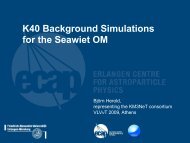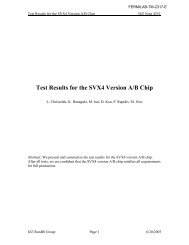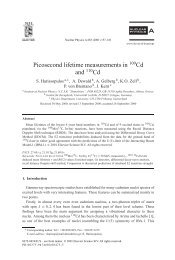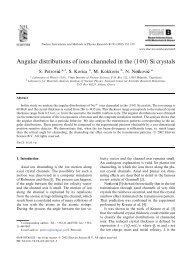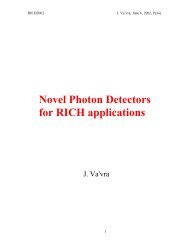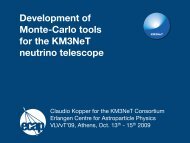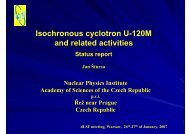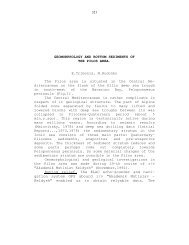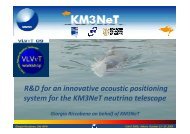"Operation and performance of the NESTOR test detector" Nucl.Instr ...
"Operation and performance of the NESTOR test detector" Nucl.Instr ...
"Operation and performance of the NESTOR test detector" Nucl.Instr ...
Create successful ePaper yourself
Turn your PDF publications into a flip-book with our unique Google optimized e-Paper software.
ARTICLE IN PRESS<br />
G. Aggouras et al. / <strong>Nucl</strong>ear <strong>Instr</strong>uments <strong>and</strong> Methods in Physics Research A 552 (2005) 420–439 421<br />
1. Introduction<br />
When high-energy neutrinos interact with matter,<br />
some <strong>of</strong> <strong>the</strong> time <strong>the</strong>y produce relativistic<br />
muons that follow closely <strong>the</strong> direction <strong>of</strong> <strong>the</strong><br />
incident neutrinos. When such interactions occur<br />
in <strong>the</strong> sea water or bedrock close to <strong>the</strong> detector,<br />
<strong>the</strong>se muons can be observed by <strong>the</strong> Cherenkov<br />
light that <strong>the</strong>y emit using arrays <strong>of</strong> sensitive optical<br />
detectors: from <strong>the</strong> arrival time <strong>and</strong> intensity <strong>of</strong> <strong>the</strong><br />
light pulses detected, <strong>the</strong> direction <strong>of</strong> <strong>the</strong> muons,<br />
<strong>and</strong> hence those <strong>of</strong> <strong>the</strong> incident neutrinos, can be<br />
reconstructed.<br />
The potential <strong>of</strong> such detectors for astronomy<br />
<strong>and</strong> cosmology has long been recognised. After <strong>the</strong><br />
pioneering work by DUMAND [1] near Hawaii,<br />
detectors are currently operating at Lake Baikal<br />
(Siberia) [2] <strong>and</strong> in ice at <strong>the</strong> South Pole<br />
(AMANDA) [3]. Construction <strong>of</strong> a large array<br />
(ICECUBE [4]) is starting at <strong>the</strong> South Pole <strong>and</strong><br />
<strong>the</strong> need for a complementary detector (1km 3 )in<br />
<strong>the</strong> nor<strong>the</strong>rn hemisphere has led to a number <strong>of</strong><br />
projects in <strong>the</strong> Mediterranean [5–8].<br />
2. Main features <strong>of</strong> <strong>the</strong> <strong>NESTOR</strong> detector, its site<br />
<strong>and</strong> infrastructure<br />
A number <strong>of</strong> reports <strong>and</strong> papers have described<br />
in detail <strong>the</strong> elements <strong>of</strong> <strong>the</strong> <strong>NESTOR</strong> detector<br />
<strong>and</strong> <strong>the</strong> techniques used for its deployment <strong>and</strong><br />
recovery [9–14]. The main features are only briefly<br />
reviewed in this section.<br />
The prerequisites for <strong>the</strong> site are deep (several<br />
km), clear water, low underwater currents, very<br />
low bioluminescent activity, minimal sedimentation<br />
<strong>and</strong> bi<strong>of</strong>ouling rates as well as close proximity<br />
to support infrastructure on shore. The <strong>NESTOR</strong><br />
site in <strong>the</strong> Ionian Sea <strong>of</strong>f <strong>the</strong> southwestern tip<strong>of</strong><br />
<strong>the</strong> Peloponesse fulfils all <strong>the</strong>se requirements.<br />
Extensive surveys in 1989, 1991 <strong>and</strong> 1992 [5,15]<br />
located a large flat plateau <strong>of</strong> 8 9km 2 in area at a<br />
mean depth <strong>of</strong> 4000 m. Situated on <strong>the</strong> side <strong>of</strong> <strong>the</strong><br />
Hellenic Trench that lies between <strong>the</strong> west coast <strong>of</strong><br />
<strong>the</strong> Peloponnese <strong>and</strong> <strong>the</strong> submarine mountain<br />
chain <strong>of</strong> <strong>the</strong> East Mediterranean Ridge, <strong>the</strong> site<br />
is well protected from major deep-water perturbations.<br />
The deepest water in <strong>the</strong> Mediterranean at<br />
5200 m is a few miles away from <strong>the</strong> <strong>NESTOR</strong> site.<br />
Very deepwater is essential in reducing <strong>the</strong><br />
principal background from muons produced by<br />
cosmic rays interacting in <strong>the</strong> Earth’s atmosphere.<br />
Also biological activity diminishes with depth.<br />
The location 1 is 7.5 nautical miles from <strong>the</strong><br />
isl<strong>and</strong> <strong>of</strong> Sapienza, where <strong>the</strong>re are two small<br />
harbours, <strong>and</strong> 11 miles from <strong>the</strong> port <strong>of</strong> Methoni,<br />
while substantial port facilities are available 15<br />
miles away in <strong>the</strong> town <strong>of</strong> Pylos on <strong>the</strong> bay <strong>of</strong><br />
Navarino.<br />
Regular measurements [16,17] <strong>of</strong> water quality<br />
show transmission lengths <strong>of</strong> 55710 m at a<br />
wavelength <strong>of</strong> 460 nm, stable temperatures <strong>of</strong><br />
14.2 1C <strong>and</strong> water current velocities well below<br />
10 cm/s [18], light bursts <strong>of</strong> 1–10 s duration,<br />
consistent with bioluminescent activity, represent<br />
around 1% <strong>of</strong> <strong>the</strong> active time <strong>and</strong> <strong>the</strong>re is little/no<br />
evidence <strong>of</strong> problems due to sedimentation or<br />
bi<strong>of</strong>ouling [19]. The sea bottom over <strong>the</strong> site has a<br />
clay deposit accumulated over some tens <strong>of</strong><br />
thous<strong>and</strong>s <strong>of</strong> years which provides for good<br />
anchoring [20].<br />
A shore station has been established in Methoni<br />
where <strong>the</strong> l<strong>and</strong> end <strong>of</strong> <strong>the</strong> 30 km long electrooptical<br />
cable is terminated. The main DC power<br />
converter for <strong>the</strong> electrical supply, <strong>the</strong> monitoring<br />
<strong>and</strong> control systems <strong>and</strong> <strong>the</strong> l<strong>and</strong> end <strong>of</strong> <strong>the</strong> data<br />
acquisition system are located in <strong>the</strong> Methoni<br />
building.<br />
The basic element <strong>of</strong> <strong>the</strong> <strong>NESTOR</strong> detector is a<br />
hexagonal floor or star. Six arms, built from<br />
titanium tubes to form a lightweight lattice girder,<br />
are attached to a central casing. Two optical<br />
modules are attached at <strong>the</strong> end <strong>of</strong> each <strong>of</strong> <strong>the</strong><br />
arms, one facing upwards <strong>and</strong> <strong>the</strong> o<strong>the</strong>r downwards.<br />
The electronics for <strong>the</strong> floor is housed in a<br />
1 m diameter titanium sphere within <strong>the</strong> central<br />
casing. The nominal floor diameter at <strong>the</strong> optical<br />
modules is 32 m.<br />
A full <strong>NESTOR</strong> tower would consist <strong>of</strong> 12 such<br />
floors stacked vertically with a spacing <strong>of</strong> 30 m<br />
between floors. This is te<strong>the</strong>red to a sea bottom<br />
unit (pyramid) [14] that contains <strong>the</strong> anchor, <strong>the</strong><br />
junction box, several environmental sensors <strong>and</strong><br />
<strong>the</strong> sea electrode that provides <strong>the</strong> electrical power<br />
1 Site coordinates: 361 37.5 0 N, 21134.6 0 E.



